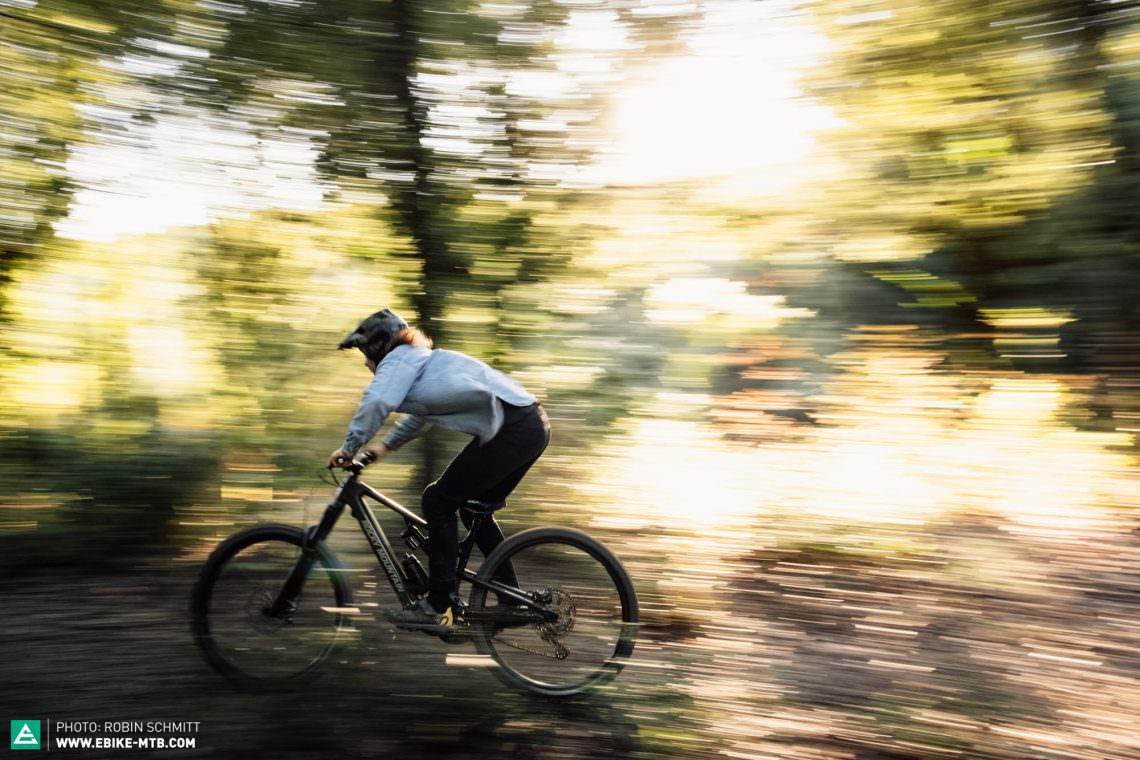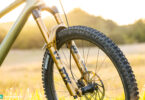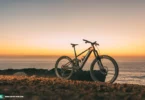For the Rocky Mountain Altitude Powerplay C70, moderation is a foreign concept: with a whopping 108 Nm torque, its Dyname 4.0 motor is the most powerful in the entire test field. But is Rocky Mountain’s boisterous eMTB just an option for experienced shredders or can it also impress as a versatile all-rounder?
For an overview of the test fleet head to the group test: The best eMTB of 2022 – 13 models in review

24.50 kg in size L | € 8,800 | Manufacturer’s website
The Altitude Powerplay C70 lacks neither motor power nor character! Rocky Mountain’s powerhouse retails at € 8,800, rolls on 29” wheels and generates 170/160 mm travel at the front and rear, respectively. The elegant carbon frame is combined with an alloy swingarm. Weight is 24.50 kg in size L. Subtract this from the 120 kg maximum permissible weight, and a fully geared-up rider weighing more than 95 kg is already too heavy for the Altitude. Particularly striking is the Dyname 4.0 motor developed in-house by Rocky Mountain, which churns out a whopping 108 Nm torque and is the most powerful motor in the entire test field. The motor is integrated into the frame triangle just above the bottom bracket and transfers its power directly to the chain via a small jockey wheel. This allows Rocky Mountain to use a high pivot suspension design. The big monochrome display integrated into the top tube can be used to fine-tune the motor characteristics. However, the motor system can’t be connected to a smartphone. The long 720 Wh battery is integrated into the slim down tube right in front of the motor and slides out from the bottom of the down tube. Although a mini thru-axle holds the battery in place, it rattles loudly inside the frame.
Power is nothing without control – only experienced riders will be able to fully exploit the 108 Nm torque.



Ready, shreddy, go! The performance-oriented spec of the Rocky Mountain Altitude Powerplay Carbon 70
Rocky Mountain rely on robust components for uncompromised trail performance. The burly FOX 38 Performance fork and X2 shock ensure a plush ride but the basic GRIP damper offers significantly fewer adjustment options than the superior GRIP2 version. The MAXXIS ASSEGAI and Minion DHR II tires come in the robust Doubledown casing and with a CushCore tire insert as standard. This setup allows you to run very low air pressures for more traction. However, the WTB aluminium wheelset doesn’t do justice to the rowdy character of the Altitude, requiring us to tighten the spokes several times. The boisterous nature of the Rocky Mountain is also too much for the 200 mm brake rotors of the Shimano XT four-piston brakes.

The lower pulley wheel serves as a torque sensor and sends the data directly to the Dyname 4.0 motor, which transfers the power directly to the chain via a small jockey wheel. To prevent the Altitude from shooting forward too abruptly, you can adjust the responsiveness of the motor.

The flip-chip in the shock mount lets you adjust the geometry of the bike in four different positions. This changes the steering and seat tube angle by approximately 1° and the progression of the rear suspension.

Only the trained eye will recognise the green CushCore valve. The tire insert holds the tires in place while ensuring excellent puncture protection at low air pressures. Together with the stable MAXXIS Doubledown tires, this provides a high level of traction.

Yes, Rocky Mountain are quoting Spaceballs to give you an idea of the “ludicrous speed” the Altitude is capable of: the Dyname 4.0 motor generates enough thrust to knock you off the saddle if you don’t hold on tightly enough.
Rocky Mountain Altitude Powerplay C70
€ 8,800
Specifications
Motor Dyname 4.0 108 Nm
Battery Powerplay Akku 720 Wh
Display Jumbotron
Fork FOX 38 Performance 170 mm
Rear Shock FOX X2 Performance 160 mm
Seatpost Race Face Aeffect R 175 mm
Brakes Shimano XT M8120 200/200 mm
Drivetrain Shimano XT 1x12
Stem Rocky Mountain 35 AM 40 mm
Handlebar Rocky Mountain AM 780 mm
Wheelset WTB ST i30 TCS 2.0 29"
Tires MAXXIS ASSEGAI / Minion DHR II DD 2.5"/2.4"
Technical Data
Size S M L XL
Weight 24.50 kg
Perm. total weight 120 kg
Max. payload (rider/equipment) 95 kg
Trailer approval no
Kickstand mount no
Specific Features
CushCore Tire inserts
extensive geometry options

The 720 Wh battery is concealed behind the down tube protector. To remove the battery, you’ll have to undo the bolt that secures the plastic cover and the mini thru-axle that keeps the battery in place.

The plush FOX suspension keeps the Altitude glued to the ground. Unfortunately, the basic GRIP damper of the FOX 38 fork offers significantly fewer adjustment options than the top-end GRIP2 cartridge. The latter would suit the Altitude’s excellent riding performance a lot better.

Heavy and fast riders should upgrade to a 220 mm front rotor for more consistent braking performance.

Using the flip-chip in the dropouts, you can change chainstay length by 10 mm. The short chainstay setting ensures a livelier character. Given its excellent composure, the Altitude doesn’t need the added stability of the longer chainstay setting. That being said, this is a great option for riders who spend lots of time climbing steep trails.
The geometry of the Rocky Mountain Altitude Powerplay C70 in detail
The geometry of the Altitude can be adapted via a flip-chip in the dropouts and shock mount. We loved the livelier short chainstay configuration combined with the slack and progressive RIDE-4 setting. The slack seat tube angle ensures a comfortable riding position and, together with the plush suspension and powerful motor, makes the Altitude suitable for longer rides. On steep fire roads, the Rocky Mountain pulls past the entire test field – and even the chair lift! However, the highly responsive Dyname 4.0 motor requires a high cadence (over 80 rpm) to stay in its optimal efficiency range and continue to provide support. On top of that, the chain makes a loud rattling noise, which takes the fun out of long days in the saddle. For long rides, you can increase the battery capacity with the optional 314 Wh range extender.
| Size | S | M | L | XL |
|---|---|---|---|---|
| Top tube | 587 mm | 612 mm | 639 mm | 673 mm |
| Seat tube | 380 mm | 420 mm | 445 mm | 480 mm |
| Head tube | 100 mm | 100 mm | 110 mm | 125 mm |
| Head angle | 63.5° | 63.5° | 63.5° | 63.5° |
| Seat angle | 75.5° | 75.5° | 75.5° | 75.5° |
| Chainstays | 439 mm | 439 mm | 439 mm | 439 mm |
| BB Drop | 34 mm | 34 mm | 34 mm | 34 mm |
| Wheelbase | 1,210 mm | 1,237 mm | 1,264 mm | 1,301 mm |
| Reach | 425 mm | 450 mm | 475 mm | 508 mm |
| Stack | 629 mm | 628 mm | 638 mm | 652 mm |

More than just a shuttle replacement? The Rocky Mountain Altitude Powerplay Carbon 70 uphill
The Altitude flexes its muscles on steep ramps and moderate climbs. “Drop the seat and lean forward!” is its mantra. This prevents the front wheel from lifting and allows you to generate good traction on both wheels. Moreover, the motor has virtually no lag: when approaching a corner, you can just take your foot off the pedal and cruise through the turn in a wide circle. Coming out of the corner, the Rocky Mountain shoots forward with the slightest pressure on the pedal and encourages you to drift or wheelie out of the turn. On technical climbs, the motor characteristics require you to time your pedal strokes carefully to avoid smashing the long 170 mm cranks into obstacles. On long climbs, you’ll have to maintain a high cadence to prevent the motor from overheating.

With Rocky Mountain’s motor, you feel like you’re pedalling an analogue bike, only with the thighs of a pro.



When setting off from a standstill, the Altitude accelerates faster than any other bike in this test and likes to get up on its rear wheel. This can be lots of fun, as long as it’s intentional.
Full throttle down into the valley – The Rocky Mountain Altitude Powerplay Carbon 70 downhill
Downhill, the plush suspension and grippy tires generate plenty of traction, making it easy to control the Altitude and inspiring huge amounts of confidence. The Rocky Mountain is extremely composed and holds its line with clinical precision, even on slippery terrain and nasty rock gardens. On moderate trails, the plush suspension swallows up the rider’s input, making it hard to pop off ledges and change direction spontaneously. As a result, the Altitude isn’t much fun to ride on flowing trails. Like the Norco Sight, it comes to life on fast trails, where it impresses with outstanding stability and excellent composure, swallowing up brake bumps and ruts and enabling super-fast speeds on rough terrain. Here only the Yeti 160E can keep up with the Altitude, getting you to the bottom of the valley just as fast but with a much bigger grin on your face.


Tuning tip: 220-mm-Bremsscheiben

The Rocky Mountain Altitude Powerplay loves it fast. The taller the berm, the more fun you’ll have!
Riding Characteristics
7Agility
- sluggish
- playful
Stability
- nervous
- stable
Handling
- demanding
- balanced
Riding fun
- boring
- lively
Motor feeling
- digital
- natural
Motor power
- weak
- strong
Value for money
- poor
- top
Conclusion
The Rocky Mountain Altitude Powerplay C70 is without a doubt the perfect fix for downhill junkies with a penchant for fast and rough trails! The powerful motor should be used primarily to make your way to the trailhead on fire roads. On challenging technical climbs, it requires an experienced rider. With its narrow and clearly-defined range of applications, the Altitude can’t hold its own against the many versatile all-rounders in our eMTB group test.
Tops
- excellent tire setup with CushCore inserts
- faster than a lift uphill
- feels at home on rough trails
Flops
- motor requires high cadence
- fragile wheelset

You can find out more about at bikes.com
The test field
For an overview of the test fleet head to the group test: The best eMTB of 2022 – 13 models in review
All bikes in test: FOCUS JAM² 7.0 (Click for review) | MERIDA eONE-SIXTY 10k (Click for review) | Norco Sight VLT C1 (Click for review) | Orbea Rise M-Team (Click for review) | Rocky Mountain Altitude Powerplay C70 | ROTWILD R.E375 PRO (Click for review) | SCOR 4060 Z ST XT (Click for review) | SCOTT Ransom eRIDE 910 (Click for review) | Specialized S-Works Turbo Levo (Click for review) | Specialized S-Works Turbo Kenevo SL (Click for review) | Trek Rail 9.9 XX1 AXS (Click for review) | Yeti 160E T1 (Click for review) | YT DECOY MX CORE 4 (Click for review)

Relaxed and comfortable riding on surfaced roads, both uphill and downhill.↩
Easy climbs up trails with few obstacles, wide turns and a moderate incline.↩
Active and playful descents on easy trails with few obstacles, wide turns and a moderate slope.↩
Single-track climbs on challenging terrain. Loose ground, steps, roots, tight corners and occasionally extreme inclines.↩
Singletrack descents on challenging terrain. Loose ground, steps, roots, tight corners and small jumps as well as some very steep descents.↩
High speed descents on sometimes very rough trails with large jumps and obstacles that you can’t roll over.↩
The rating used for riding characteristics refers to the bikes in the group test and the current state of development of eMTBs. The best bikes managed to blend supposedly opposite riding characteristics, feeling both lively and stable at the same time. The handling describes the balance of the bike on downhill sections. The information regarding motor-power refers to the ride-feeling in the overall context of the bike and not exclusively to the motor – that’s why the same motor can present different values.↩
Did you enjoy this article? If so, we would be stoked if you decide to support us with a monthly contribution. By becoming a supporter of E-MOUNTAINBIKE, you will help secure a sustainable future for high-quality cycling journalism. Click here to learn more.
Words: Rudolf Fischer Photos: Robin Schmitt









